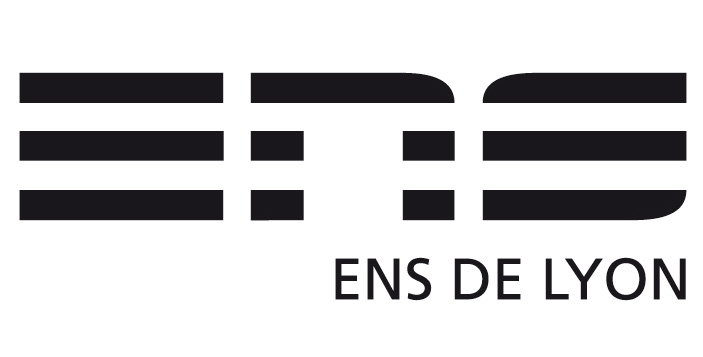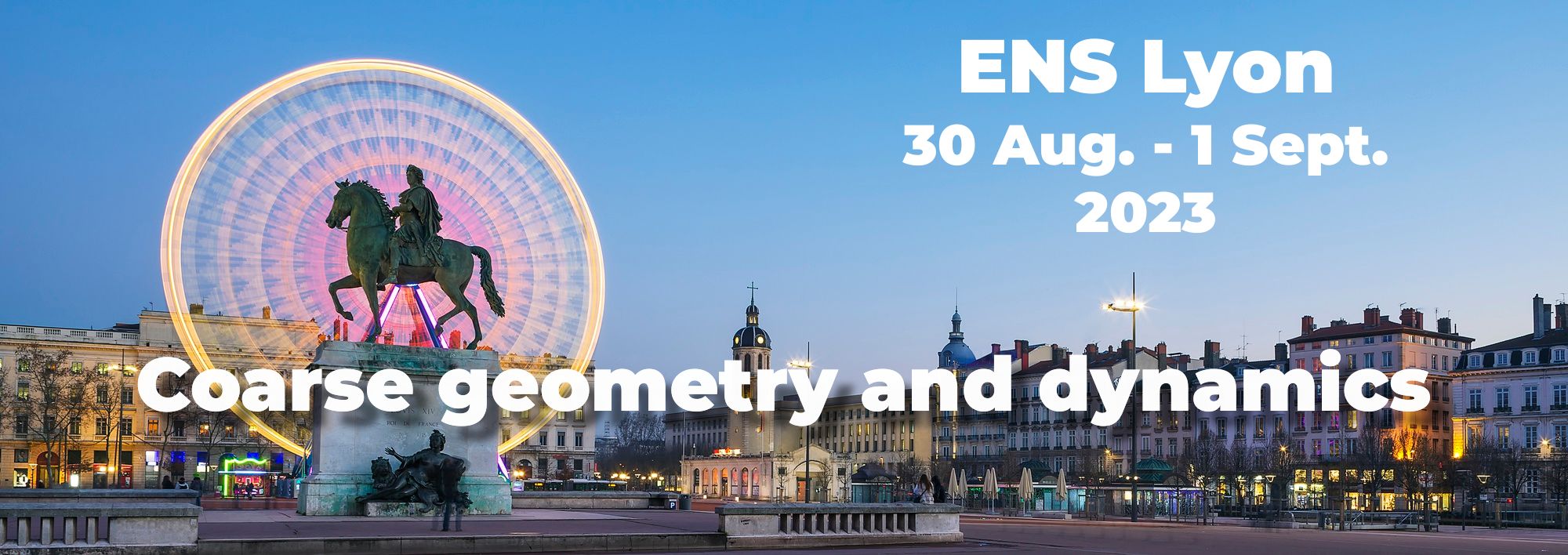ENS Lyon
30 August - 1 September 2023
Coarse geometry and dynamics
The ENS Lyon will host a workshop bringing together researchers from the fields of coarse geometry, geometric and measured group theory, dynamics and operator algebras in a 3 days conference. Mini-courses by Piotr Nowak (Mathematical Institute of the Polish Academy of Sciences) and Corina Ciobotaru (Aahrus University, Denmark) will take place in the morning, and will be accessible for graduate students.
Information
Please click on the accordion below.
Naomi Andrew (University of Oxford)
Kevin Boucher (Southampton University)
Alice Bouillet (ENS de Lyon)
Qian Chen (ENS de Lyon)
Corina Ciobotaru (University of Aarhus)
Corentin Correia (IMJ-PRG)
Clément Dell’Aiera (ENS Lyon)
Antoine Derimay (ENS Lyon)
Antoine Etesse (ENS de Lyon)
Amandine Escalier (Universität Münster)
Uwe Franz (Université de Franche-Comté)
Martín Gilabert (Institut Camille Jordan)
Yassine Guerch (ENS Lyon)
Fabien Hoareau (Université Paris-Cité)
Sam Hughes (University of Oxford)
Mao Kai (Institut Polytechnique de Paris)
François Le Maître (Institut Mathématiques de Jussieu, Paris 7)
Antonio Lopez-Neumann (Institut Polytechnique de Paris)
Amine Marrakchi (ENS Lyon)
Nicolás Matte Bon (Université Lyon 1)
Basile Morando (ENS Lyon)
Piotr Nowak (University of Warsaw)
Antoine Poulin (McGill University)
Samantha Pilgrim (University of Glasgow)
Yigang Qiu (IMJ-PRG-Paris 7)
Alain Valette (Université de Neuchâtel)
Benjamin Zarka (Université Côte d’Azur)
Wednesday, August 30
08:30 - 09:00 Welcome in Salle Passerelle
09:00 - 10:30 Corina Ciobotaru
11:00 - 12:30 Piotr Nowak
14:00 - 15:00 François Le Maître
15:10 - 16:10 Amandine Escalier
Coffee break
16:45 - 17:45 Sam Hughes
Thursday, August 31
09:00 - 10:30 Corina Ciobotaru
11:00 - 12:30 Piotr Nowak
14:00 - 15:00 Antoine Poulin
15:10 - 16:10 Kevin Boucher
Coffee break
16:45 - 17:45 Naomi Andrew
20:00 Conference diner at Le Gabion
Friday, September 1
09:00 - 10:30 Piotr Nowak
11:00 - 12:30 Corina Ciobotaru
14:00 - 15:00 Uwe Franz
15:10 - 16:10 Samantha Pilgrim
Final coffee
Corina Ciobotaru, An introduction to Bruhat-Tits buildings
A building is an important notion in Mathematics which was introduced by Bruhat and Tits around 1970-1980 in order to classify algebraic groups over an arbitrary field. Having at once a combinatorial and geometric structure, a building simultaneously generalizes certain aspects of flag manifolds, finite projective planes, and Riemannian symmetric spaces. They play a central role in the fields of geometric group theory (i.e. the study of Coxeter groups, CAT(0) spaces, etc...), the representation theory of algebraic groups, or discrete mathematics. The aim of this course is to give a fair introduction to the subject via the concrete example of the Bruhat-Tits building of \(SL_n(\mathbb Q_p)\). If time permits, at the end of the lectures we will employ the geometry of the freshly constructed affine building to compute Chabauty limits of various subgroups of \(SL_n(\mathbb Q_p)\). Lecture notes will be provided.
Piotr Nowak, Large scale geometry of group actions
In these these lectures I will describe a construction of a metric space out of an action of a finitely generated group on a compact space, the so called warped cones introduced by John Roe. I will then survey some of their coarse geometric properties, connections to box spaces and expanders.
Reading material
Ciobotaru, An introduction to Bruhat-Tits buildings, Lecture notes (2023)
Naomi Andrew, Centralisers in (outer) automorphism groups
Given a group G, we can ask about its subgroups. Centralisers of elements are easy to define, but maybe not so easy to understand: even in such well studied groups as \(Out(\mathbb F_n)\) they are not yet understood in general. I'll discuss work with Armando Martino where we extend what is known in \(Out(\mathbb F_n)\), involving a (surprising?) connection to free-by-cyclic groups and their automorphisms as well as working with actions on trees. The strategies seem like they should apply in many more cases, and as time allows I'll discuss ongoing work (with Gilbert Levitt and Armando Martino) exploring these possibilities.
Kevin Boucher, Uniformly bounded representations of hyperbolic groups
After an introduction to the subject of boundary representations of hyperbolic groups, I will present some recent development motivated by a spectral formulation of the so-called Shalom conjecture.
This a joint work with Dr Jan Spakula.
Slides here.
Amandine Escalier, Quantitative measure equivalence and graph products
Measure equivalence was introduced by Gromov in the 90’s. Although presented as a measure theoretical analogue of quasi-isometry, measure equivalence sometimes crushes two groups with very different geometries to a same equivalence class. Recently, Delabie, Koivisto, Le Maître and Tessera introduced a quantitative version of measure equivalence, which aims to specify how close the two equivalent actions are.
In this talk we will focus on the behavior of graph products under quantitative measure equivalence. Through this study, we will highlight the links between the latter notion and geometric properties. This is joint work with Camille Horbez.
Slides here.
Uwe Franz, Gaussian parts of compact quantum groups
Compact quantum groups, as introduced by Woronowicz in the 1980's, are unital C*-algebras with additional structure, which generalise the algebra of continuous functions on a compact group. Many notions and results from the theory of compact groups, like the Haar measure, their Peter-Weyl representation theory, and Tannaka-Krein duality, extend to this more general framework. In this talk I will propose a definition of connectedness and the connected component of the unit for compact quantum groups, motivated by Schürmann definition of Gaussianity for Lévy processes on involutive bialgebras. We will see that for commutative compact quantum groups these definitions are equivalent to the classical definitions. Next we will consider new features that arise in the noncommutative case, and finally we will determine the `connected component of the unit' (which we dub `Gaussian part') for several examples of interest. The talk will conclude with several related open problems.
Sam Hughes, Dynamics and finite quotients of free-by-cyclic groups
In this talk we will investigate to what extent we can distinguish two free-by-cyclic groups by their finite quotients. I will present recent work joint with Monika Kudlinska proving that there exist at most finitely many free-by-cyclic groups with the same finite quotients as a generic free-by-cyclic group. The talk will focus on explaining how we encode some of the dynamics of a free-by-cyclic group into its finite quotients.
François Le Maître, On quantitative orbit equivalence for actions of the group of integers
Dye's theorem informs us that up to conjugacy, all probability measure-preserving ergodic actions of countable infinite amenable groups share the same orbits, so that the theory of orbit equivalence trivializes for such groups. Quantitative orbit equivalence aims at remembering more information than just the orbits, notably by putting additional conditions on the cocycles one obtains once two actions share the same orbits. In this talk, I will try to give an overview of what is known for actions of the easiest countable infinite amenable group, namely the group of integers.
Samantha Pilgrim, The Dynamic Asymptotic Dimension and Coarse Geometry
We will give an introduction to the dynamic asymptotic dimension of Guentner, Willett, and Yu and describe some connections with geometry. This dimension theory for group actions appears as though it should be sensitive to the topology of the space being acted on (the definition involves open sets) but we will see it often coincides with the asymptotic dimension of the acting group. Our approach takes inspiration from coarse geometry, especially the study of box spaces.
Slides here.
Antoine Poulin, Quasi-treeable equivalence relations
It is known that free actions of virtually free groups are treeable. We prove an analoguous results for locally finite Borel graphs G: if every G component is quasi-isometric to a tree, then the equivalence relation is treeable, under the conditions that the G-components be one-ended or have bounded degree.
Slides here.
The talks will be held in the ENS Lyon (building Monod), 4th floor, in lecture hall A (Amphi A).
How to get there?
Coming from Part-Dieu train station, hop on the subway, line B, direction Gare d'Oullins, and exit at station Debourg.
Coming from Lyon-Saint-Exupéry Airport, get on RhôneExpress to Part-Dieu train station, and then apply the previous instruction. RhôneExpress is distinct from Lyon transportation system, tickets can be purchased in advance here.
Hôtel
The participants can stay at the hotel Appart'city Lyon Gerland, located at 175, Avenue Jean Jaurès, 69007 LYON.
A vegetarian buffet is scheduled for Thursday lunch in the Salle Passerelle. Other lunches are in the university restaurant called CROUS.
A diner is scheduled on Thursday evening, at Le Gabion.
What to do in Lyon?
If you never visited, here are some ideas.
- La Cathédrale Saint-Jean and the Old town
- Croix-Rousse, a historic neighborhood
- La Basilique Notre-Dame de Fourvière (which you can access via the old town by taking the funiculaire with a subway ticket) and the Roman Amphitheater
- Le parc de la tête d'Or
- Walking along le Rhône ou la Saône is very nice
- Lyon has a lot of very good and diverse restaurants, typical of which are les Bouchons (not vegetarian)
Suggestion of a touristic itinerary
Funding


